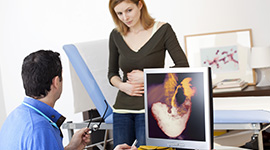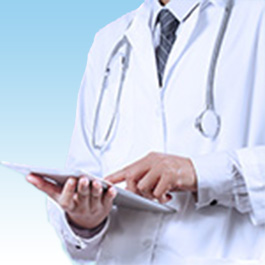

 The Digestive Disease Clinic at YAS healthcare provides state-of-the-art medical care to patients through the comprehensive evaluation, diagnosis and treatment of gastrointestinal disorders and liver disease.
The Digestive Disease Clinic at YAS healthcare provides state-of-the-art medical care to patients through the comprehensive evaluation, diagnosis and treatment of gastrointestinal disorders and liver disease.
Our American Board certified doctor will assist you in various aspects of Gastroenterology including colon cancer screening procedures, treatment of GERD, inflammatory bowel disease, irritable bowel syndrome, ulcer disease and treatment of diseases of the liver, biliary system, and pancreas.
For more information about specific procedures and the preparation required kindly check the links below.
A colonoscopy is a test that looks at the inner lining of a person’s large intestine. The large intestine is also called the colon. Often, people have colonoscopy as a screening test to check for polyps or for cancer in the colon or rectum. Polyps are growths in the colon that might turn into cancer. If you have polyps, the doctor can take them out during the colonoscopy. People can also have colonoscopy if they have any of the symptoms listed below. Cancer screening tests are tests that are done to try and find cancer early, before a person has symptoms. Cancer that is found early often is small and can be cured or treated easily.
Doctors can use 5 or 6 different tests to screen for colon cancer. But most doctors think that colonoscopy is the best test to screen for colon cancer.
Doctors recommend that most people begin having colon cancer screening at age 50. Some people have an increased chance of getting colon cancer, because of a strong family history or certain medical conditions. These people might begin screening at a younger age.
Your doctor might order a colonoscopy if you have:
Your doctor will give you instructions about what to do before a colonoscopy. He or she will tell you what foods you can and cannot eat. He or she will also tell you if you need to stop taking any of your usual medicines beforehand. Make sure to read the instructions as soon as you get them. You might have to stop some medicines up to a week before the test.
The colon needs to be cleaned out before a colonoscopy. Your doctor will give you a special drink that causes watery diarrhea. It is important to drink all of it to make sure your colon is clean. If your colon is clean your doctor will get a better look at the inside lining of the colon. A clean colon also makes the test easier to do and more comfortable. Let your doctor know if you have trouble getting ready for your colonoscopy.
Your doctor will give you medicine to make you feel relaxed. Then he or she will put a thin tube with a camera and light on the end into your anus and up into the rectum and colon. Your doctor will look at the inside lining of the whole colon.
During the procedure, your doctor might do a test called a biopsy. During a biopsy, a doctor takes a small piece of tissue from the colon. Then he or she looks at the tissue under a microscope to see if it has cancer. Your doctor might also remove growths that he or she sees in the colon. You will not feel it if the doctor takes a biopsy or removes a growth.
Your doctor will give you instructions about what to do after a colonoscopy. Most people can eat as usual. But most doctors recommend that people do not drive or go to work for the rest of the day. Your doctor will tell you when to start taking any medicines you had to stop before the test.
Call your doctor or nurse immediately if you have any of the following problems after your colonoscopy:
Upper endoscopy is a procedure that lets a doctor look at the lining of the upper digestive tract. The upper digestive tract includes the esophagus (the tube than connects the mouth to the stomach), the stomach, and the duodenum (the first part of the small intestine).
You might have an upper endoscopy if you have:
Your doctor will give you instructions about what to do before an upper endoscopy. He or she will tell you if you need to stop eating or drinking, or stop taking any of your usual medicines beforehand. Make sure to read the instructions as soon as you get them. You might have to stop some medicines up to a week before the test. Let your doctor know if you have trouble getting ready for your upper endoscopy.
You will have an IV (needle) put in your arm or hand. Your doctor will give you medicines through the IV to make you feel relaxed. He or she might give you a mouth spray or gargle to numb your mouth. You will also get a plastic mouth guard to protect your teeth.
Then your doctor will put a thin tube with a camera and light on the end into your mouth and down into your esophagus, stomach, and duodenum. He or she will look for irritation, bleeding, ulcers, or growths.
During an upper endoscopy, your doctor might also:
After an upper endoscopy, you will be watched for 1 to 2 hours until the medicines wear off. Most doctors recommend that people not drive or go to work right after an upper endoscopy. Most can drive and go back to work the next day.
The most common side effect is feeling bloated. Some people have nausea because of the medicines used before the procedure. If this happens to you, your doctor can give you medicine to make the nausea better. Most people can eat as usual after the procedure.
Call your doctor or nurse immediately if you have any of the following problems after your upper endoscopy:
A flexible sigmoidoscopy is an examination of the lower part of the gastrointestinal tract called the colon or large intestine. It is performed by an endoscopist, who is a doctor or other health professional with special training in endoscopic procedures. There are several reasons that flexible sigmoidoscopy may be recommended, with one of the most common reasons being the need to screen for colon cancer in people older than 50 years.
Colonoscopy allows the clinician to examine the entire large intestine and is preferred in certain situations.
A healthcare provider will provide specific Instructions about how to prepare for the examination. The instructions are designed to maximize your safety during and after the examination, minimize complications, and allow the endoscopist to easily view the colon. It is important to read these instructions ahead of time and follow them carefully. Call your clinician or the endoscopy unit if you have questions.
The lower part of the colon must be cleaned to permit the endoscopist to see the inside lining of the colon. You will be given specific instructions, with preparation often including a clear liquid diet, laxatives, and use of an enema shortly before the examination.
Some medications, such as iron preparations, may need to be stopped one to two weeks before the examination. Iron coats the colon, making it difficult to see the lining. If you take these medications, you should ask your healthcare provider if they need to be stopped before the procedure. People who take a blood thinning medication, such as warfarin (Coumadin®), should consult with their clinician regarding the need to stop taking this medication temporarily.
Most medications for high blood pressure, heart disease, lung disease, and seizure disorders are safe during sigmoidoscopy and can be taken the day of the examination. Medications for diabetes may need to be adjusted before the test; talk to your healthcare provider for advice.
Prior to the sigmoidoscopy, a nurse will ask questions to be sure that you understand the procedure and the reason it is planned. A doctor will review the procedure, including possible complications, and will ask you to sign a consent form.
Flexible sigmoidoscopy usually takes between 5 and 15 minutes. It is performed while you lie on your left side with your legs bent like they would be if you were sitting in a chair. The sigmoidoscope, which is approximately the size of one finger, is inserted into the anus and advanced through the rectum, sigmoid colon, and descending colon. The sigmoidoscope has a camera and a light source that permits the endoscopist to see the inside of the colon on a television monitor.
The endoscope can be used to take biopsies (small pieces of tissue) and to introduce or withdraw fluid or air. Biopsies do not hurt because the lining of the colon does not sense pain. However, you may feel cramping as air is introduced through the scope and as the scope is passed through segments of the colon. The air is needed to permit the endoscopist to advance the scope and see the lining of the colon.
It is common to feel embarrassed about releasing air through your rectum, although this is recommended to decrease discomfort. Let the endoscopist know if there is discomfort, since air can also be removed through the scope. Because the procedure is brief and discomfort is mild, pain medications or sedation are not routinely used.
Flexible sigmoidoscopy is a safe procedure and complications are rare.
The following symptoms should be reported immediately:
Although patients worry about discomforts of the examination, most people tolerate it very well and feel fine afterwards. Most patients are able to return to normal activities, including eating, after the examination. In many cases, you can go to work and drive the same day, provided you did not receive any medications that could interfere with these activities (such as medications used for sedation).
You should contact your doctor about the results of your test and if you have any questions. The endoscopy team will let you know when all the results will be available and if further treatment is necessary.

Qualification
American Board of Gastroenterology
American Board of Internal Medicine
Areas of Interest
Food intolerance and coeliac intolerance